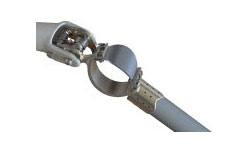3 min read

With the Ingenuity helicopter’s fifth successful flight on Mars, the first one-way flight, a lot of attention has been deservedly focused on the performance of the helicopter rotor and its aerodynamics. However, there has been another subsystem on the helicopter that has been hard at work ever since the helicopter was dropped onto the surface – its feet.
First of all, the four feet keep the helicopter stable and upright, even when it’s not flying! Any tip-over of the aircraft would almost certainly leave the blades damaged and unable to fly. A common question, especially for those who have seen the movie The Martian, is whether Ingenuity would get blown over by the strong Martian winds or flung aloft by one of the dust devils that commonly pass through the area. Thanks to the thin atmosphere (1% of Earth’s), wide landing gear stance (45° tip-over angle), and low center of gravity (40% of the mass is in the fuselage), the parked helicopter can easily withstand winds in excess of 135 mph, far beyond what we expect to encounter.
The other question we get about the Ingenuity helicopter is whether Ingenuity could bounce and tip over during a landing on Mars. This is an instinctive concern for anyone familiar with small aircraft such as this. Note that Ingenuity is not going to land gently – it will attempt to fly in winds as high as 22 mph. Our strategy for landing in windy conditions is to come down with authority—placing Ingenuity’s feet firmly on the ground so that it won’t drift across the surface of Mars and snag a foot on a rock.

To withstand these firm landings, Ingenuity is equipped with a cushy suspension system as shown in this figure. Notice the distinctive open hoop structure at each corner of the fuselage where the landing legs attach. The lower half of this hoop is a titanium spring that can bend as much as 17 degrees to provide 3.5 inches of motion in the suspension, while the upper half is a soft non-alloyed aluminum flexure that serves as the damper or “shock absorber.” By plastically deforming and fatiguing as it absorbs energy, this flexure acts much like the crumple zone structure of a car chassis. However, unlike a car or the crumple-cushioned landing gear of the Apollo moon landers, Ingenuity’s titanium springs rebound after each impact to pull these aluminum dampers back into shape for the next landing. The aluminum damper gets a little bit weaker with each cycle as cracks and creases develop. While it would eventually break after a few hundred hard landings, with only a few flights scheduled for this demonstration, that’s a problem we could only dream of having.
Written by J. (Bob) Balaram, Ingenuity Helicopter Chief Engineer &
Jeremy Tyler, Senior Aero/Mechanical Engineer for the Mars Helicopter Project at AeroVironment.
Written by Bob Balaram, NASA’s Jet Propulsion Laboratory & Jeremy Tyler, AeroVironment







